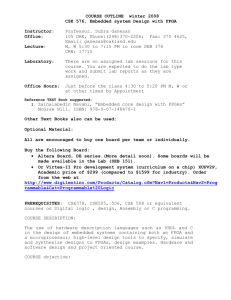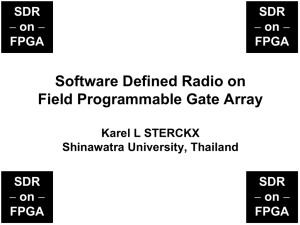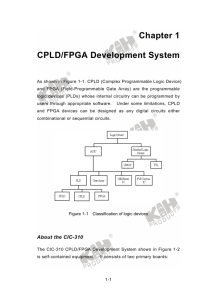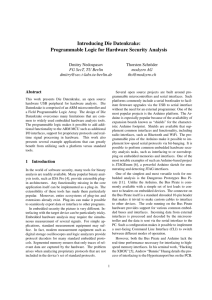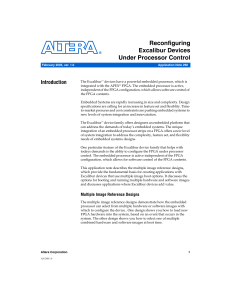ECE 576
advertisement
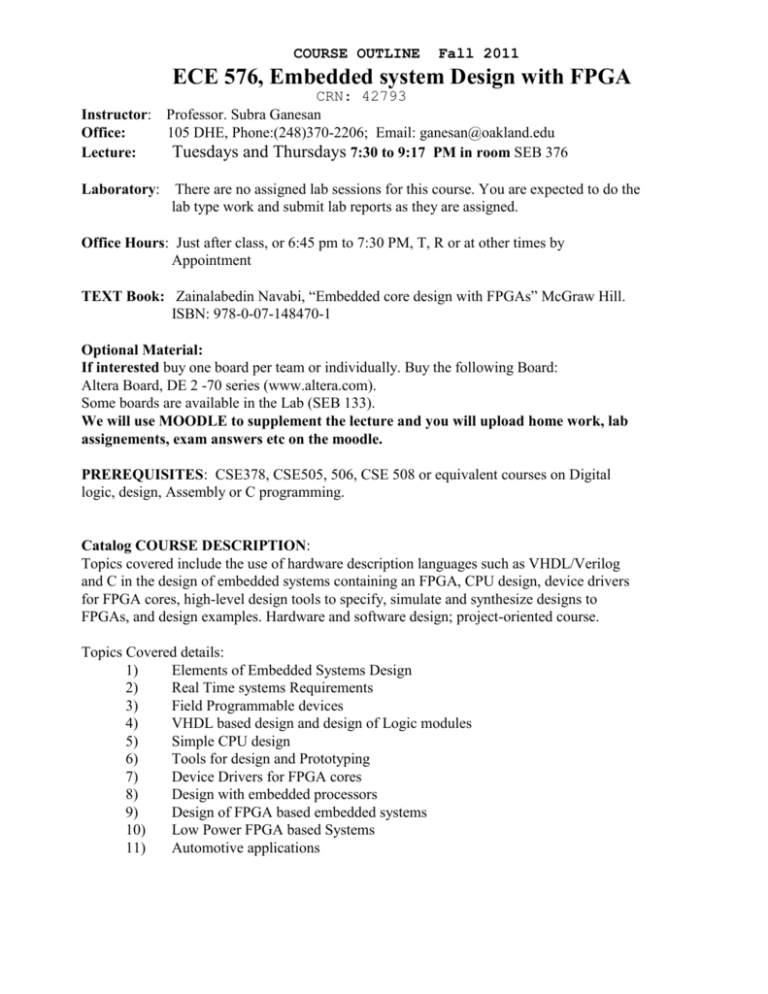
COURSE OUTLINE Fall 2011 ECE 576, Embedded system Design with FPGA Instructor: Office: Lecture: Laboratory: CRN: 42793 Professor. Subra Ganesan 105 DHE, Phone:(248)370-2206; Email: ganesan@oakland.edu Tuesdays and Thursdays 7:30 to 9:17 PM in room SEB 376 There are no assigned lab sessions for this course. You are expected to do the lab type work and submit lab reports as they are assigned. Office Hours: Just after class, or 6:45 pm to 7:30 PM, T, R or at other times by Appointment TEXT Book: Zainalabedin Navabi, “Embedded core design with FPGAs” McGraw Hill. ISBN: 978-0-07-148470-1 Optional Material: If interested buy one board per team or individually. Buy the following Board: Altera Board, DE 2 -70 series (www.altera.com). Some boards are available in the Lab (SEB 133). We will use MOODLE to supplement the lecture and you will upload home work, lab assignements, exam answers etc on the moodle. PREREQUISITES: CSE378, CSE505, 506, CSE 508 or equivalent courses on Digital logic, design, Assembly or C programming. Catalog COURSE DESCRIPTION: Topics covered include the use of hardware description languages such as VHDL/Verilog and C in the design of embedded systems containing an FPGA, CPU design, device drivers for FPGA cores, high-level design tools to specify, simulate and synthesize designs to FPGAs, and design examples. Hardware and software design; project-oriented course. Topics Covered details: 1) Elements of Embedded Systems Design 2) Real Time systems Requirements 3) Field Programmable devices 4) VHDL based design and design of Logic modules 5) Simple CPU design 6) Tools for design and Prototyping 7) Device Drivers for FPGA cores 8) Design with embedded processors 9) Design of FPGA based embedded systems 10) Low Power FPGA based Systems 11) Automotive applications COURSE objective: Upon successful completion of the course students will be able to: Write VHDL and C language Codes to implement Embedded system design on FPGA boards. use an A/D converter to read analog signals into FPGA board generate pulse-width modulation (PWM) signals on a FPGA board for controlling the speed of a dc motor or the position of a servo Describe how to design using FPGA with microcontroller core. work in a team environment to design a microprocessor-based system and communicate the results in a written report and an oral presentation At periodic intervals, we will check whether the course objectives have been met. LABORATORY There will be lab assignments using FPGA development boards, with emphasis on design. The laboratory projects will be both hardware and software assignments. Students should work as a team in the labs. You can work on the lab assignments at any time using your own FPGA boards or the ones in the lab. Each student has to Submit on or before November 20, 2011, all the lab Programs listings at the moodle. For each lab include objective, a flow chart, hardware interface details, and VHDL/C programs with comments.(i.e. Upload the lab programs with comments.) PROJECT Each student (team) must work on a term project during the second half of the course. The project must be completed and tested before the due date mentioned below. Project title and brief abstract is due on: October 16 Progress report I (Hardware/ software detail and component list) due on: October 23 Presentation in the lecture room Nov 29, December 1 Demonstration of the project in the laboratory: December 1 Final Project report is due on: December 1 EXAMINATION AND GRADE POLICY. Exam I: (Open book; Design questions) Sept 29 15% Exam II: (Open book; Design questions) October 27 15% Theoretical Design project,(Take Home, 1 week time) due on December 8 20% Laboratory Assignments 15% Project: Report/Demonstration/presentation: 10+10+5= 25% Home work 10% Attendance taken every class. GRADING POLICY: 55% and 95% of the total score will be 1.0 and 4.0 respectively. The grading curve is linear between 1.0 and 4.0. Grading policy may be modified if the average of the exams/score is very low. One should get 50% or above in each of the above, i.e. Exams, Project, Lab, HW. Homework Assignments You need to submit the homework AND Lab assignments on the Moodle on or before the due dates mentioned in the class. Class Attendance Everyone is recommended to actively participate in the class. The instructor will take class attendance; It is students’ advantage to attend the lectures. If anyone has to miss any classes, he/she is advised to collect a copy of the lecture notes from a colleague and to make arrangements with a colleague for picking-up any materials distributed on those days. Students are responsible for knowing all the verbal and written information provided by the instructor, including those that are posted on the course web-site. Web site/ moodle will not substitute the instructor. Writing Style and Guidelines for the Reports Please make the best use of the flowcharts, block diagrams, tables, figures, and pictures in your writing. Use of screen captured images is discouraged. Leave a one-inch margin all around the pages, and write about 30 lines per page. Texts and programs should be formatted in 11 to 12 points Roman-like and 10 to 11 points Courier-like fonts, respectively. The *.lst files can be printed in 8 to 9 points Courier-like fonts. Programs should be well commented and neatly formatted. Reports should be professional in quality and appearance. They should follow the standard guidelines for engineering report writing. Write them as a series of paragraphs, subsections, sections, and chapters. Unless otherwise specified, all submissions must follow these guidelines. Course Evaluation Students are required to perform the on-line course evaluation at the end of the semester. Academic Conduct: Students are expected to practice and uphold standards of academic integrity and honesty. Examples of dishonesty: cheating in exams, labs, and home work; Plagiarizing the work of others, unauthorized collaborations on computer assignments . Please refer the Graduate or Undergraduate catalog for details. LAB REPORT Lab report has to be submitted in a folder by each student on or before November 20, 2011. Note: Eventhough you do the lab as a team, the lab report is submitted by each student. Use the report submission guideline sheet enclosed with the first day handout. First describe briefly about the lab setup and board. For each lab include objective, a flow chart, hardware interface details, and code with comments. A disk with all the lab programs should be included in the folder. Labs emphasize design of software, hardware and interface. Include in the appendix, details or data sheets of A/D, D/A or any other special chip you have used in the lab. There is no need to include the FPGA chip data sheet.
